Huawei Technologies G6800 GSM Mobile Phone User Manual
Huawei Technologies Co.,Ltd GSM Mobile Phone Users Manual
Users Manual
i
Contents
1 Getting Started ..................................................................... 1
Installing the SIM Card and Battery ................................... 1
Removing the Battery and SIM Card .................................. 1
Installing and Removing a microSD Card ........................... 2
Charging the Battery ......................................................... 2
2 Getting to Know Your Phone ................................................. 3
Your Phone ....................................................................... 3
Keys and Functions ........................................................... 4
Screen Icons ..................................................................... 5
Using the Touchscreen ...................................................... 6
Locking and Unlocking the Screen ..................................... 6
Home Screen .................................................................... 7
Customizing the Screen .................................................... 8
Opening the Notification Panel ......................................... 8
3 Voice Services ....................................................................... 9
Making a Call ................................................................... 9
Answering a Call ............................................................... 9
Call Settings .................................................................... 10
4 Contacts .............................................................................11
Opening the Contacts Application ................................... 11
Creating a Contact .......................................................... 11
Searching for a Contact .................................................. 11
Importing Contacts from a SIM Card ............................... 12
Exporting Contacts to a SIM Card .................................... 12
ii
5 Text Input ............................................................................13
QWERTY Keyboard ......................................................... 13
Changing the Text Input Mode ........................................ 14
Entering a Word ............................................................. 14
Entering a Number ......................................................... 14
Entering a Symbol ........................................................... 15
Copying, Pasting and Cutting Text ................................... 15
6 Messaging ..........................................................................16
Sending a Text or Multimedia Message ........................... 16
Email .............................................................................. 17
7 Multimedia ..........................................................................19
Browser .......................................................................... 19
Camcorder ..................................................................... 19
FM Radio ........................................................................ 22
Music ............................................................................. 23
Recorder ......................................................................... 24
SNS ................................................................................ 25
8 Network and Connectivity ....................................................26
Bluetooth ....................................................................... 26
Cellular Network ............................................................. 27
WLAN ............................................................................ 27
9 Managing Your Phone .........................................................29
Download Management ................................................. 29
Application Management................................................ 29
Connection Management ............................................... 29
File Management ............................................................ 30
Contacts Backup ............................................................. 30
iii
10 Applications ......................................................................31
Alarm ............................................................................. 31
Calculator ....................................................................... 31
Calendar ......................................................................... 31
Converter ....................................................................... 31
Ebook (Optional) ............................................................. 31
Gallery ............................................................................ 32
Notes ............................................................................. 32
SIM Tool Kit .................................................................... 32
Stopwatch (Optional) ...................................................... 32
Task ................................................................................ 32
Weather ......................................................................... 32
World Clock (Optional) ................................................... 32
11 Warnings and Precautions ..................................................33
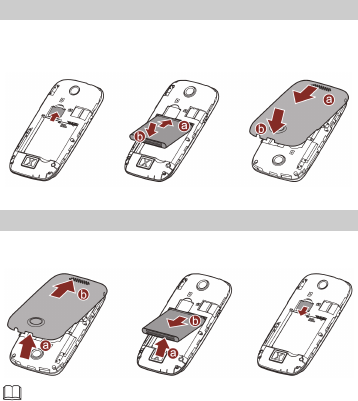
1
1 Getting Started
Installing the SIM Card and Battery
When installing the subscriber identity module (SIM) card, ensure
that the gold contact area faces down, and that the beveled edge
of the SIM card aligns with that of the SIM card slot.
Removing the Battery and SIM Card
Before removing the battery and SIM card, ensure that your phone
is powered off.
Please be careful around the USB port when you remove the
battery cover.
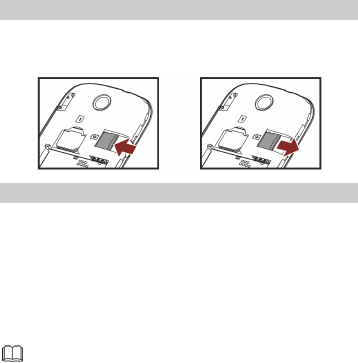
2
Installing and Removing a microSD Card
You can expand your phone's memory capacity by installing a
microSD card. When installing a microSD card, ensure that the
gold contact area faces down.
Charging the Battery
1. Connect the small end of the USB cable to the phone's charger
jack and the large end to the charger.
2. Connect the charger to a power outlet.
3. Wait until the battery is fully charged.
When the battery is charging, the charging icon blinks. When
the charging icon stops blinking, the battery is fully charged.
4. Unplug the charger from the power outlet and the USB cable
from the phone.
When the battery is charging, the indicator light next to
the earpiece will automatically turn on. The color of the
light indicates the battery level status (Red: the battery
level is below 15; Orange: the battery level is between
15% and 90%; Green: the battery level is over 90%).
When you have missed calls, unread messages, missed
alarms, or other alerts, the indicator light will be blinking
green.
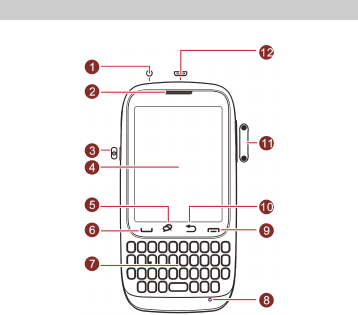
3
2 Getting to Know Your Phone
Your Phone
The following figure shows the appearance of your phone.
1 Headset jack 2 Earpiece
3 Power key 4 Screen
5 SNS key 6 Call key
7 Keypad 8 Microphone
9 End key 10 Back key
11 Volume key 12 Charger jack/Micro Universal
Serial Bus (USB) port
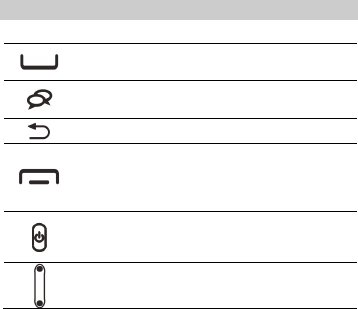
4
Keys and Functions
Access Call log in standby mode.
Make a call.
Access social networking services (SNS) in standby
mode.
Return to the previous menu.
Return to standby mode.
Reject or end a call.
View the thumbnail of five screens in standby
mode.
Power the phone on or off (press and hold the
key for about 3 seconds).
Lock the screen when your phone is powered on.
Adjust the volume.
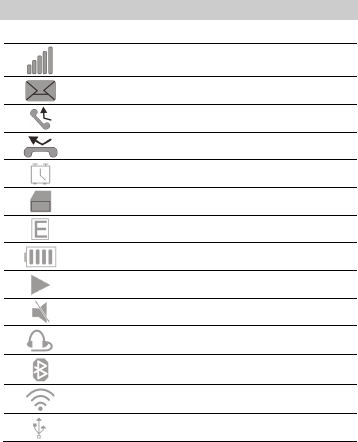
5
Screen Icons
Signal strength.
New messages.
Call forwarding enabled.
Missed calls.
Alarms enabled.
microSD card installed.
Cellular network in use.
Battery level.
Music playing.
Silent profile activated.
Headset connected.
Bluetooth on.
WLAN connected.
USB connected.
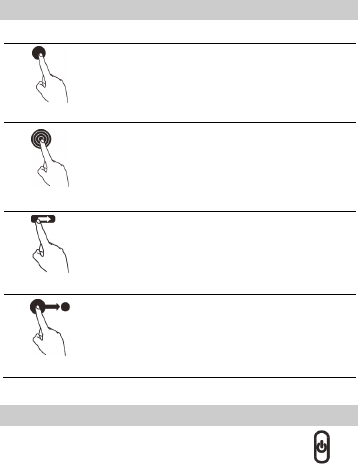
6
Using the Touchscreen
Touch
Touch the screen with your finger to select an
item, confirm a selection, or start an
application.
Touch and hold
Touch an item with your finger and continue to
press down until your phone responds. For
example, to open the options menu for the
active screen, touch the screen and hold down
until the menu appears.
Flick
Move your finger across the screen either
vertically or horizontally. For example, flick left
or right to switch between pictures.
Drag
Touch and hold the desired item with your
finger. Drag the item to any part of the screen.
You can drag an icon to move or delete it.
Locking and Unlocking the Screen
When your phone is on and the screen is displayed, press to
lock the screen. You can still receive messages and calls during this
time.
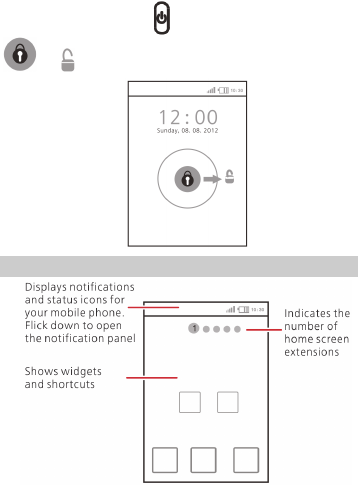
7
Similarly, if you leave your mobile phone undisturbed for a short
while, the screen will lock automatically.
To unlock the screen, press to wake the screen, and drag
to .
Home Screen

8
Customizing the Screen
Changing the Style of Icons
1. In standby mode, touch > Application icons.
2. Select the desired style, and touch OK.
Changing Special Effects
1. In standby mode, touch > Switch FX.
2. Flick up or down to view the list of available effects and select
the desired effect.
Changing the Home Screen Wallpaper
1. In standby mode, touch and hold a blank area, and touch
Wallpaper.
2. Touch System provided or Gallery, and select a picture to set as
the wallpaper.
Moving an Item
1. Touch and hold an item on the home screen until the item
jumps, or touch and hold an item on the main menu until the
item is enlarged and a pale shade appears behind it.
2. Without lifting your finger, drag the item to a desired position,
and release your finger to save it to that position.
Opening the Notification Panel
To open the notification panel, drag the notification bar
downward.
Drag the notification panel upward to hide it.
From the notification panel, you can view your service provider,
notifications, and reminders.
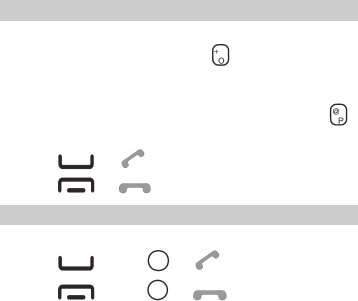
9
3 Voice Services
To make a phone call, you can dial a number by using the dialer or
touch a number saved in your contacts list, call log, or messages.
When you are in a call, you can answer other incoming calls or
redirect them to your voicemail. You can also set up conference
calls with several participants.
Making a Call
1. In standby mode, enter a phone number.
To make an international call, press to enter the plus sign
(+). Then enter the country or region code, area code, and
phone number.
To call an extension, enter the switchboard number, press
to enter P, and enter the extension number.
2. Touch or to dial the number.
3. Touch or to end the call.
Answering a Call
When you have an incoming call:
Touch or drag to to answer the call.
Touch or drag to to reject the call.
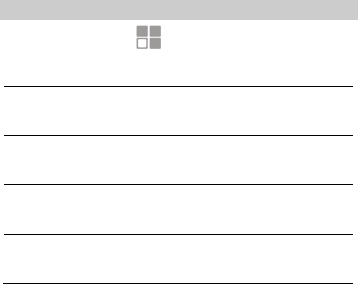
10
Call Settings
In standby mode, touch > Settings > Call settings to
customize your call settings.
Black list
If this function is enabled, your phone will
automatically reject numbers in the black
list.
White list
If this function is enabled, your phone will
automatically answer numbers in the white
list.
Reject by SMS
If this function is enabled, your phone will
automatically send an SMS message to a
rejected number.
Auto answer
If this function is enabled, your phone will
automatically answer a call when a headset
is plugged in.
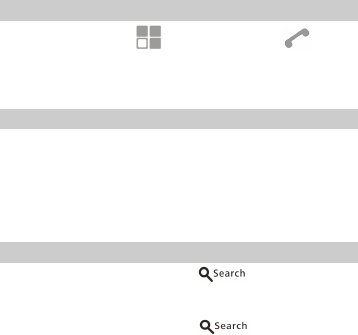
11
4 Contacts
The Contacts application lets you save and manage contact
information, such as phone numbers and addresses. This gives you
easy access to your friends and family.
Opening the Contacts Application
In standby mode, touch > Contacts, or touch >
Contacts.
All your contacts are displayed alphabetically in a list. You can
choose to display your contacts by their first and last names first
Creating a Contact
1. From the Contacts screen, touch Add contact.
2. Enter the contact's information, such as the name, phone
number, and email.
3. Touch Save to save the contact.
The default storage is Phone. To change the default storage, touch
More > Settings > Contacts storage.
Searching for a Contact
1. From the Contacts screen, touch .
2. Enter the name of the contact you want to search for. As you
type, the phone displays candidate contacts that may be spelt
by the keystroke sequence under .

12
Importing Contacts from a SIM Card
1. From the Contacts screen, touch More > Settings > Import
contacts > SIM.
2. Mark your desired contacts, and touch Import to import the
contacts. You can select Mark all to import all contacts.
Exporting Contacts to a SIM Card
1. From the Contacts screen, touch More > Settings > Export
contacts > SIM.
2. Mark your desired contacts, touch Export to export the
contacts. You can select Mark all to export all contacts.
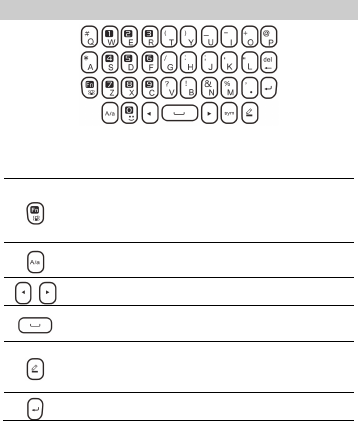
13
5 Text Input
QWERTY Keyboard
The following table describes the functions of the phone's
non-letter keys.
Enter a number or symbol labeled on the upper
left corner of a key (press this key and the key of
the desired number or symbol; press this key twice
to continuously enter numbers or symbols).
Switch between the upper and lower cases in text
editing mode.
Move the cursor.
Enter a space in text editing mode.
Confirm a selection in text editing mode.
Select the text input mode in text editing mode.
Select a language in text editing mode (press and
hold this key for about 3 seconds).
Start a new paragraph in text editing mode.
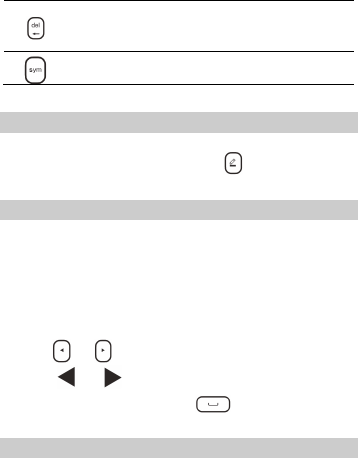
14
Delete the last entered character.
Delete all the entered characters instantly (press
and hold this key for about 3 seconds).
Display the symbol list in text editing mode.
Changing the Text Input Mode
In text editing mode, the current text input mode is displayed in
the upper left corner of the screen. Press once to open the
input mode list where you can select a desired input mode.
Entering a Word
To enter a word in abc input mode, press the keys labeled with the
letters that spell the word.
To enter a word in Smart abc input mode:
1. Press each key according to the spelling sequence of the
desired word.
The phone displays candidate words that may be spelt by the
keystroke sequence.
2. Press or to scroll to the desired word.
Touch or to turn pages.
3. Touch the desired word or press to enter the selected
word.
Entering a Number
To enter a number, press the desired number key in Numeric input
mode.

15
Entering a Symbol
To enter a symbol, press to display the symbol list, and touch
the desired symbol.
To enter a commonly used symbol, press and a key labeled
with that symbol.
Copying, Pasting and Cutting Text
You can copy, paste, and cut text on your phone. For example, you
can copy text from web pages and paste them to your emails,
messages, or notes.
Copying Text
1. Find the text you want to copy.
2. Touch and hold the text, and touch Select Text.
3. Drag your finger to the end of the text.
4. Release your finger from the screen, and select Copy.
Pasting Text
Touch and hold a text box on an email, message, or note, and
touch Paste.
Cutting Text
Touch and hold a text box on an email, message, or note, and
touch Cut all.

16
6 Messaging
Sending a Text or Multimedia Message
In standby mode, touch > Messaging > New msg. .
Before using the multimedia messaging service (MMS), contact
your service provider to determine whether MMS is available and
how to subscribe to it.
To send a text or multimedia message:
1. Touch To: enter the phone number of a recipient. You can also
add the phone number from Contacts by touching .
2. Touch Tap to compose to write the message.
If you want to send a text message, go to step 5.
If you want to send a multimedia message, go to step 3.
3. Select More > Add subject to add a subject to the message.
4. Touch Insert for the following options:
Multimedia: add an image, video, or audio file to the
message.
Attachment: add vCard, vEvent, vTask, or File to the
message.
Slide: add slides to the message.
If you add Multimedia, Attachment, Slide, or a subject, the
message automatically changes from a text message to a
multimedia message.
5. Touch Send to send the message.

17
Your phone supports multimedia messages up to 300 KB.
Exercise caution when opening multimedia messages.
Objects in multimedia messages may contain viruses or
malicious software that can damage your phone.
Email
In standby mode, touch > Email.
Before you can send or receive emails, add and activate an email
account.
Make sure you have a stable network to send and receive emails.
Adding an Email Account
1. Touch Create to add an account.
2. Touch the desired email service, including Gmail, Yahoo,
Hotmail and Others.
3. Enter Email address and Password.
Touch Settings > New account to add more accounts. Simply
repeat the preceding steps.
Activating an Email Account
1. After adding an account, touch Settings > Default account.
2. Touch the desired email account to activate it.
Writing and Sending an Email
1. Select an email account you want to send from and touch New
Email.
2. Touch To to enter a recipient's email address.
3. Touch Input the subject to add the email subject.
4. Touch the text box to write the email.
5. Touch Insert to add attachments.
18
6. After you finish writing the email, you can:
Send: send the email.
Save: save the email as a draft.
Cc/Bcc: copy or blind copy the email.

19
7 Multimedia
Browser
In standby mode, touch > Opera.
You do not need to set your data account and Wireless Access
Protocol (WAP) parameters to access (WAP) sites.
For details about Internet service and potential fees, contact your
service provider.
Opening a Web Page
1. In a browser window, touch the address box at the top of the
screen.
2. Enter a web page address.
3. Touch Go to open the web page.
Customizing Browser Settings
In a browser window, touch then Settings. You can then
customize the browser and configure its privacy and security
settings.
Camcorder
In standby mode, touch > Camcorder.
Camera
The camera opens in landscape mode by default, and you can take
a picture right away. After a picture is taken, you can set the
picture as a contact's profile picture or the wallpaper, as well as
delete or share it.
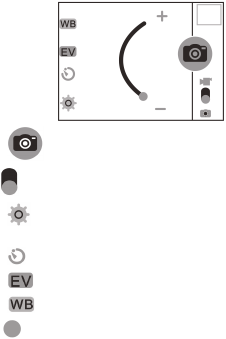
20
From the viewfinder screen:
Touch to take a picture.
Slide to switch to video recording mode.
Touch to configure settings such as the picture quality,
storage location, resolution, and others.
Touch to set the self-timer.
Touch to set the exposure.
Touch to set the white balance.
Drag to zoom in or zoom out.
Video Recorder
You can use the video recorder function to continuously record the
best moments. You can also delete or share the recorded videos.
From the video recorder screen:
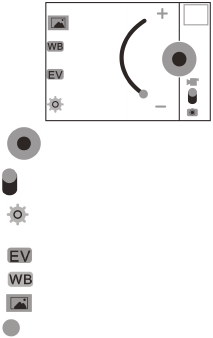
21
Touch to start recording.
Slide to switch to camera mode.
Touch to configure settings such as the video quality,
storage location, limitations, and others.
Touch to set the exposure.
Touch to set the white balance.
Touch to select light mode.
Drag to zoom in or zoom out.
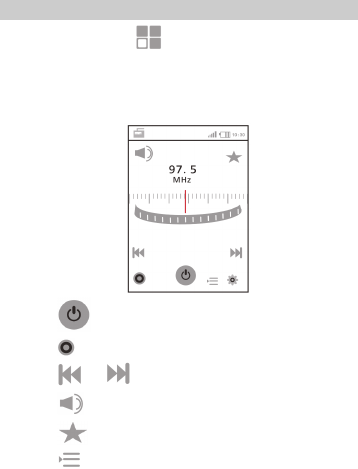
22
FM Radio
In standby mode, touch > FM radio.
For the best possible reception, connect a headset to the phone
before using FM radio. Do not disconnect the headset from the
phone or bend the headset cable when using FM radio.
From the FM radio screen:
Touch to stop or continue.
Touch to record the current channel.
Touch or to switch to an adjacent channel.
Touch to enable speaker.
Touch to add the current channel to favorites.
Touch to view the channel list, search for and save
channels automatically, and modify the favorites list.
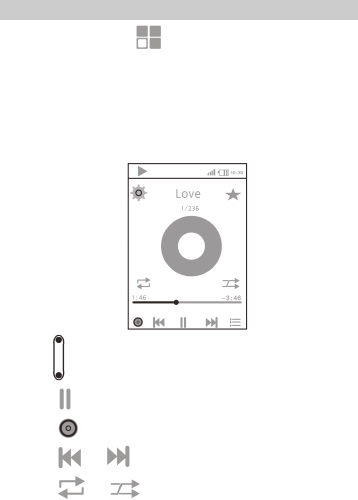
23
Music
In standby mode, touch > Music.
The Music application lets you play audio clips stored in the phone
memory and microSD card. For better sound quality, it is
recommended that you use a headset.
Audio clips are categorized by Artists, Albums, Songs and Playlists.
Select an audio file to start playing the clip.
From the Music screen:
Press to adjust the volume.
Touch to pause.
Touch return to Songs.
Touch or to switch between audio files.
Touch or to select the play mode.
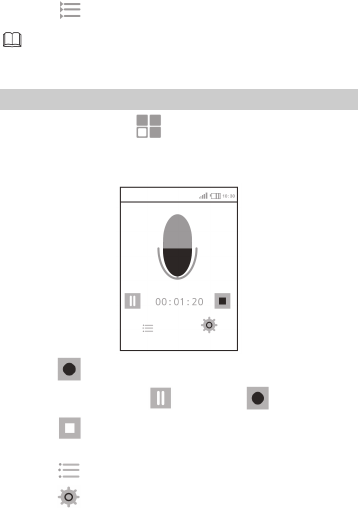
24
Touch to view the current playlist.
Touch and hold an audio clip to add it to Playlists or Delete
it.
Recorder
In standby mode, touch > Recorder.
The Recorder application lets you digitally record audio.
From the Recorder screen:
Touch to record an audio clip.
When recording, touch to pause or to continue.
Touch to stop recording, and the clip will be saved
automatically.
Touch view Record list.
Touch to configure settings such as Storage and
Recording quality.

25
SNS
Your phone supports several built-in social media applications,
such as Facebook Chat, Facebook, twitter, MSN, and Gtalk. These
applications let you send and receive instant messages and files.
Make sure your general packet radio service (GPRS) or wireless
local area network (WLAN) connection is on, and a microSD card is
installed before using the applications.

26
8 Network and Connectivity
Bluetooth
You can transfer data between your phone and other Bluetooth
devices, and talk on the phone using a Bluetooth headset.
Connecting a Bluetooth Device to Your Phone
1. In standby mode, touch > Settings > Network &
connectivity, and enable Bluetooth.
2. Select Bluetooth settings > Paired devices, and touch Search to
search for available Bluetooth devices.
3. Select the desired Bluetooth device.
4. Enter the password to pair the Bluetooth device with your
phone.
When a Bluetooth device is connected with the phone for the
first time, you may need to enter a pairing password for
verification.
Transferring Data
To transfer data (using pictures as an example) between your
phone and a Bluetooth device:
1. In standby mode, touch > Gallery > My shootings.
2. Touch Share, and select the desired pictures.
3. Touch Share again, and select the desired Bluetooth device.
4. Wait for that Bluetooth device to accept the incoming pictures.

27
Cellular Network
Your phone will be automatically configured to use your service
provider’s GPRS and Enhanced Data rates for GSM Evolution (EDGE)
service (if available) when you turn the phone on for the first time.
Note that changing these settings may prevent you from accessing
the Internet.
1. In standby mode, touch > Settings > Network &
connectivity.
2. Enable Data service.
You can enable Data roaming. Note that using data
services while roaming may incur additional charges.
Contact your service provider for details about data
roaming charges.
WLAN
WLAN lets you access the Internet wirelessly. To use WLAN on your
phone, you must have an access to wireless access points.
Obstacles such as walls may block WLAN signals and reduce the
signal strength.
Turning WLAN On
1. In standby mode, touch > Settings > Network &
connectivity.
2. Enable WLAN.
Connecting to a WLAN
1. In standby mode, touch > Settings > Network &
connectivity > WLAN settings.

28
2. A list of detected WLAN networks is displayed under WLAN
networks.
3. Select the desired WLAN network.
If you select an open network, you will be automatically
connected to that network.
If you select a network that is secured with Wired Equivalent
Privacy (WEP) and connect to the network for the first time,
enter the password as prompted, and touch Join. If you
connect to a secure wireless network that you have previously
joined, you will not be prompted to enter the password again
unless you have reset your phone to its default settings.
From the WLAN settings screen, touch Add network to add
a new WLAN network.

29
9 Managing Your Phone
Download Management
In standby mode, touch > Downloads.
You can view files in Downloading and Completed, pause or
resume downloading files, and clear all completed downloads.
Application Management
In standby mode, touch > App. mgr. .
You can manage the listed Applications and Widgets. Touch
Settings to configure MRE settings or Widget settings. Touch an
application or widget then Restore to restore the application or
widget to its default settings, or touch Advanced for additional
options.
Connection Management
In standby mode, touch > Conn. mgr. .
Your current network connection type (WLAN or GPRS) will be
displayed, and you can view Connection status, Connection time,
and All date size for it.
You can touch Disconnect all to disconnect your phone from all
connections, or select a connection and touch Disconnect to
disconnect from that connection.

30
File Management
In standby mode, touch > File mgr. .
The File mgr. application lets you organize files stored in your
phone memory and microSD card. You can also use the
application to view images, listen to music, and watch videos.
Contacts Backup
You can back up and restore contacts from your phone memory or
SIM card. Ensure that a microSD card is installed.
To back up contacts:
1. In standby mode, touch > Contacts > More > Settings >
Backup contacts, or touch > Settings > Contacts
settings > Backup contacts.
2. Select Phone or SIM as the location you wish to back up
contacts from.
To restore backup data:
1. In standby mode, touch > Contacts > More > Settings >
Restore contacts, or touch > Settings > Contacts
settings > Restore contacts.
2. Select the desired backup file you wish to restore.
3. Touch Restore.

31
10 Applications
Alarm
The Alarm application lets you set new alarms or modify existing
alarms.
You can set the alert time, repetition, and ring type.
Once an alarm has been set, the alarm icon is displayed on the
notification panel.
Calculator
The Calculator application lets you perform basic arithmetic
operations.
Calendar
The Calendar application lets you add events to the calendar and
keep track of them.
Converter
The Converter application lets you convert units of Weight, Length,
and Currency. Select two units for each category, enter the value
for one unit, and the result for the other unit will display
automatically.
Ebook (Optional)
The Ebook application lets you read ebooks in .txt format.
The phone automatically adds ebooks stored in the My ebooks
folder of the microSD card to the Book list.
Features marked with "optional" are optional. These
features may vary according to your service provider.

32
Gallery
The Gallery application lets you manage and enjoy pictures and
videos stored in the phone memory or microSD card.
Notes
The Notes application lets you view, add, edit, categorize, and
delete notes.
SIM Tool Kit
The SIM Toolkit (STK) application is provided only by some service
providers. It lets you send messages, read the news, and use other
carrier-unique services. For details, contact your service provider.
Stopwatch (Optional)
Your phone equips with Typical stopwatch and nWay stopwatch.
Select a type of stopwatch to measure time.
Task
The Task application lets you view, add, edit, and delete tasks.
Once a task is added, the phone rings at the user-defined time to
remind you of that specific task.
Weather
The Weather application is provided by AccuWeather.com and lets
you look up the most accurate and up-to-date weather
information for your chosen city.
World Clock (Optional)
The World clock application lets you view the time, date, and time
zone of global cities listed in the application. You can add two
additional cities to the application home screen for quick viewing.
33
11 Warnings and Precautions
This section contains important information pertaining to the
operating instructions of your device. It also contains information
about how to use the device safely. Read this information carefully
before using your device.
Electronic Device
Power off your device if using the device is prohibited. Do not use
the device when using the device causes danger or interference
with electronic devices.
Medical Device
Follow rules and regulations set forth by hospitals and health
care facilities. Do not use your device when using the device is
prohibited.
Pacemaker manufacturers recommend that a minimum
distance of 15 cm be maintained between a device and a
pacemaker to prevent potential interference with the
pacemaker. If you are using a pacemaker, use the device on the
opposite side of the pacemaker and do not carry the device in
your front pocket.
Potentially Explosive Atmosphere
Power off your device in any area with a potentially explosive
atmosphere, and comply with all signs and instructions. Areas that
may have potentially explosive atmospheres include the areas
where you would normally be advised to turn off your vehicle
engine. Triggering of sparks in such areas could cause an explosion
or a fire, resulting in bodily injuries or even deaths. Do not power
on your device at refueling points such as service stations. Comply
with restrictions on the use of radio equipment in fuel depots,
storage, and distribution areas, and chemical plants. In addition,
34
adhere to restrictions in areas where blasting operations are in
progress. Before using the device, watch out for areas that have
potentially explosive atmospheres that are often, but not always,
clearly marked. Such locations include areas below the deck on
boats, chemical transfer or storage facilities, and areas where the
air contains chemicals or particles such as grain, dust, or metal
powders. Ask the manufacturers of vehicles using liquefied
petroleum gas (such as propane or butane) whether this device
can be safely used in their vicinity.
Traffic Security
Observe local laws and regulations while using the device. In
addition, if using the device while driving a vehicle, comply with
the following guidelines:
Concentrate on driving. Your first responsibility is to drive safely.
Do not talk on the device while driving. Use hands-free
accessories.
When you have to make or answer a call, park the vehicle at
the road side before using your device.
RF signals may affect electronic systems of motor vehicles. For
more information, consult the vehicle manufacturer.
In a motor vehicle, do not place the device over the air bag or
in the air bag deployment area. Otherwise, the device may hurt
you owing to the strong force when the air bag inflates.
Do not use your device while flying in an aircraft. Power off
your device before boarding an aircraft. Using wireless devices
in an aircraft may cause danger to the operation of the aircraft
and disrupt the wireless telephone network. It may also be
considered illegal.
Operating Environment
Do not use or charge the device in dusty, damp, and dirty
places or places with magnetic fields. Otherwise, it may result
in a malfunction of the circuit.
35
The device complies with the RF specifications when the device
is used near your ear or at a distance of 1.5 cm from your body.
Ensure that the device accessories such as a device case and a
device holster are not composed of metal components. Keep
your device 1.5 cm away from your body to meet the
requirement earlier mentioned.
On a stormy day with thunder, do not use your device when it
is being charged, to prevent any danger caused by lightning.
When you are on a call, do not touch the antenna. Touching
the antenna affects the call quality and results in increase in
power consumption. As a result, the talk time and the standby
time are reduced.
While using the device, observe the local laws and regulations,
and respect others' privacy and legal rights.
Keep the ambient temperature between 0°C and 40°C while
the device is being charged. Keep the ambient temperature
between 0°C to 40°C for using the device powered by a
battery.
Prevention of Hearing Damage
Using a headset at high volume can damage your hearing. To
reduce the risk of damage to hearing, lower the headset volume
to a safe and comfortable level.
Safety of Children
Comply with all precautions with regard to children's safety.
Letting the child play with your device or its accessories, which
may include parts that can be detached from the device, may be
dangerous, as it may present a choking hazard. Ensure that small
children are kept away from the device and accessories.
Accessories
Use the accessories delivered only by the manufacturer. Using
accessories of other manufacturers or vendors with this device
model may invalidate any approval or warranty applicable to the
36
device, result in the non-operation of the device, and cause
danger.
Battery and Charger
Unplug the charger from the electrical plug and the device
when not in use.
The battery can be charged and discharged hundreds of times
before it eventually wears out. When the standby time and the
talk time are shorter than the normal time, replace the battery.
Use the AC power supply defined in the specifications of the
charger. An improper power voltage may cause a fire or a
malfunction of the charger.
Do not connect two poles of the battery with conductors, such
as metal materials, keys, or jewelries. Otherwise, the battery
may be short-circuited and may cause injuries and burns on
your body.
Do not disassemble the battery or solder the battery poles.
Otherwise, it may lead to electrolyte leakage, overheating, fire,
or explosion.
If battery electrolyte leaks out, ensure that the electrolyte does
not touch your skin and eyes. When the electrolyte touches
your skin or splashes into your eyes, wash your eyes with clean
water immediately and consult a doctor.
If there is a case of battery deformation, color change, or
abnormal heating while you charge or store the battery,
remove the battery immediately and stop using it. Otherwise, it
may lead to battery leakage, overheating, explosion, or fire.
If the power cable is damaged (for example, the cord is
exposed or broken), or the plug loosens, stop using the cable at
once. Otherwise, it may lead to an electric shock, a short circuit
of the charger, or a fire.
Do not dispose of batteries in fire as they may explode.
Batteries may also explode if damaged.
37
Danger of explosion if battery is incorrectly replaced. Recycle or
dispose of used batteries according to the local regulations or
reference instruction supplied with your device.
Notice: For pluggable equipment, the socket-outlet shall be
installed near the equipment and shall be easily accessible.
Cleaning and Maintenance
The device, battery, and charger are not water-resistant. Keep
them dry. Protect the device, battery, and charger from water
or vapor. Do not touch the device or the charger with a wet
hand. Otherwise, it may lead to a short circuit, a malfunction of
the device, and an electric shock to the user.
Do not place your device, battery, and charger in places where
they can get damaged because of collision. Otherwise, it may
lead to battery leakage, device malfunction, overheating, fire,
or explosion.
Do not place magnetic storage media such as magnetic cards
and floppy disks near the device. Radiation from the device
may erase the information stored on them.
Do not leave your device, battery, and charger in a place with
an extreme high or low temperature. Otherwise, they may not
function properly and may lead to a fire or an explosion. When
the temperature is lower than 0°C, performance of the battery
is affected.
Do not place sharp metal objects such as pins near the earpiece.
The earpiece may attract these objects and hurt you when you
are using the device.
Before you clean or maintain the device, power off the device
and disconnect it from the charger.
Do not use any chemical detergent, powder, or other chemical
agents (such as alcohol and benzene) to clean the device and
the charger. Otherwise, parts of the device may be damaged or
38
a fire can be caused. You can clean the device and the charger
with a piece of damp and soft antistatic cloth.
Do not dismantle the device or accessories. Otherwise, the
warranty on the device and accessories is invalid and the
manufacturer is not liable to pay for the damage.
Emergency Call
You can use your device for emergency calls in the service area.
The connection, however, cannot be guaranteed in all conditions.
You should not rely solely on the device for essential
communications.
Certification Information (SAR)
This device meets guidelines for exposure to radio waves.
Your device is a low-power radio transmitter and receiver. As
recommended by international guidelines, the device is designed
not to exceed the limits for exposure to radio waves. These
guidelines were developed by the independent scientific
organization International Commission on Non-Ionizing Radiation
Protection (ICNIRP) and include safety measures designed to
ensure safety for all users, regardless of age and health.
The Specific Absorption Rate (SAR) is the unit of measurement for
the amount of radio frequency energy absorbed by the body when
using a device. The SAR value is determined at the highest certified
power level in laboratory conditions, but the actual SAR level of
the device when being operated can be well below the value. This
is because the device is designed to use the minimum power
required to reach the network.
The SAR limit adopted by USA and Canada is 1.6 watts/kilogram
(W/kg) averaged over one gram of tissue. The highest SAR value
reported to the FCC and IC for this device type when tested for use
at the ear is 0.720 W/kg, and when properly worn on the body is
1.340 W/kg.
39
The SAR limit also adopted by Europe is 2.0 W/kg averaged over
10 grams of tissue. The highest SAR value for this device type
when tested at the ear is 0.648 W/kg, and when properly worn on
the body is 0.968 W/kg.
FCC Statement
This equipment has been tested and found to comply with the
limits for a Class B digital device, pursuant to Part 15 of the FCC
Rules. These limits are designed to provide reasonable protection
against harmful interference in a residential installation. This
equipment generates, uses and can radiate radio frequency energy
and, if not installed and used in accordance with the instructions,
may cause harmful interference to radio communications.
However,there is no guarantee that interference will not occur in a
particular installation.If this equipment does cause harmful
interference to radio or television reception,which can be
determined by turning the equipment off and on, the user is
encouraged to try to correct the interference by one or more of
the following measures:
Reorient or relocate the receiving antenna.
Increase the separation between the equipment and receiver.
Connect the equipment into an outlet on a circuit different
from that to which the receiver is connected.
Consult the dealer or an experienced radio/TV technician for
help.
This device complies with Part 15 of the FCC Rules. Operation is
subject to the following two conditions: (1) this device may not
cause harmful interference, and (2) this device must accept any
interference received, including interference that may cause
undesired operation.
Warning: Changes or modifications made to this device not
expressly approved by Huawei Technologies Co., Ltd. may void the
FCC authorization to operate this device.

40
Disposal and Recycling Information
This symbol on the device (and any included batteries) indicates
that they should not be disposed of as normal household garbage.
Do not dispose of your device or batteries as unsorted municipal
waste. The device (and any batteries) should be handed over to a
certified collection point for recycling or proper disposal at the end
of their life.
For more detailed information about the recycling of the device or
batteries, contact your local city office, the household waste
disposal service, or the retail store where you purchased this
device.
The disposal of this device is subject to the Waste from Electrical
and Electronic Equipment (WEEE) directive of the European Union.
The reason for separating WEEE and batteries from other waste is
to minimize the potential environmental impacts on human health
of any hazardous substances that may be present.
Reduction of Hazardous Substances
This device is compliant with the EU Registration, Evaluation,
Authorisation and Restriction of Chemicals (REACH) Regulation
(Regulation No 1907/2006/EC of the European Parliament and of
the Council) and the EU Restriction of Hazardous Substances
(RoHS) Directive (Directive 2002/95/EC of the European Parliament
and of the Council). For more information about the REACH
compliance of the device, visit the Web site
www.huaweidevice.com/certification. You are recommended to
visit the Web site regularly for up-to-date information.

41
EU Regulatory Conformance
Hereby, Huawei Technologies Co., Ltd. declares that this device is
in compliance with the essential requirements and other relevant
provisions of Directive 1999/5/EC.
For the declaration of conformity, visit the Web site
www.huaweidevice.com/certification.
Notice: Observe the national local regulations in the location
where the device is to be used. This device may be restricted for
use in some or all member states of the European Union (EU).
Norway: This subsection does not apply for the geographical area
within a radius of 20 km from the centre of Ny-Ålesund.
Please visit www.huaweidevice.com/worldwide/support/hotline for
recently updated hotline and email address in your country or
region.

42
Copyright © Huawei Technologies Co., Ltd. 2012. All
rights reserved.
Trademarks and Permissions
, , and are trademarks or
registered trademarks of Huawei Technologies Co., Ltd.
Other trademarks, product, service and company names
mentioned are the property of their respective owners.
The Bluetooth® word mark and logos are registered trademarks
owned by Bluetooth SIG, Inc. and any use of such marks by
Huawei Technologies Co., Ltd. is under license. Other trademarks
and trade names arethose of their respective owners.
NO WARRANTY
THE CONTENTS OF THIS MANUAL ARE PROVIDED "AS IS". EXCEPT
AS REQUIRED BY APPLICABLE LAWS, NO WARRANTIES OF ANY
KIND, EITHER EXPRESS OR IMPLIED, INCLUDING BUT NOT LIMITED
TO, THE IMPLIED WARRANTIES OF MERCHANTABILITY AND
FITNESS FOR A PARTICULAR PURPOSE, ARE MADE IN RELATION TO
THE ACCURACY, RELIABILITY OR CONTENTS OF THIS MANUAL.
TO THE MAXIMUM EXTENT PERMITTED BY APPLICABLE LAW, IN
NO CASE SHALL HUAWEI TECHNOLOGIES CO., LTD BE LIABLE FOR
ANY SPECIAL, INCIDENTAL, INDIRECT, OR CONSEQUENTIAL
DAMAGES, OR LOST PROFITS, BUSINESS, REVENUE, DATA,
GOODWILL OR ANTICIPATED SAVINGS.